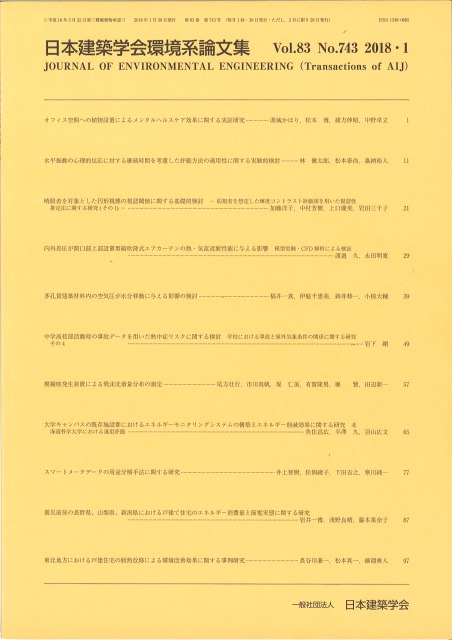
- Transactions of the Institute of Japanese Architects
- Transactions of the Architectural Institute of Japan
- Transactions of the Architectural Institute of Japan
- Transactions of the Architectural Institute of Japan Summaries of Technical Papers
- Journal of Structural and Construction Engineering (Transactions of AIJ)
- |<
- <
- 1
- >
- >|
-
The Lewis number during dew condensation in laboratory experimentKaori KOBAYAKAWA, Daisuke OGURA, Kazuya KOMINAMI2024Volume 89Issue 819 Pages 234-240
Published: May 01, 2024
Released on J-STAGE: May 01, 2024
JOURNAL FREE ACCESSThe amount of condensation water on the window glass surface is determined by multiplying the window glass area, the absolute humidity difference, and the moisture transfer coefficient. The moisture transfer coefficient is determined from the convective heat transfer coefficient and the Lewis number. Therefore, it is essential to identify the Lewis number in order to calculate the condensation water content. In this study, the Lewis number was calculated from the experimental results of temperature, wind velocity, and condensation water weight, and it was confirmed that the Lewis number for window condensation is 1.7 to 2.1 with curtains.
View full abstractDownload PDF (1469K) -
Simulation study using a model of an all-electric detached experimental houseMinayo IMAI, Jungmin KIM, Mizuho AKIMOTO, Kanta AMADA, Seiichi KASHIHA ...2024Volume 89Issue 819 Pages 241-250
Published: May 01, 2024
Released on J-STAGE: May 01, 2024
JOURNAL FREE ACCESSTo address increasing power outages caused by natural disasters in Japan, enhancing resilient net Zero Energy Houses (ZEH) is crucial. In addition, pregnant women, infants, home care patients, and the elderly require special consideration for disaster prevention. This study aims to evaluate the resilience of ZEH for power outages by household composition and storage battery (BT) capacity. The self-sufficiency rate of electricity and the thermal environment were calculated. As a result, when vulnerable groups live together, BT capacity and BT residuals need to be increased due to increased power demand for cooking appliances, artificial respirator, etc.
View full abstractDownload PDF (1420K) -
Ken SHOJI, Shinsuke KATO2024Volume 89Issue 819 Pages 251-257
Published: May 01, 2024
Released on J-STAGE: May 01, 2024
JOURNAL FREE ACCESSIn this study, we propose a quantitative evaluation method and criteria for aerosol infection risk. By using the Wells-Riley model, we derived the infection probability and calculated the number of secondary infections in a room considering spatial distribution, thus setting the infection risk assessment value. As a criterion for containing the infection, we adopted the condition that the number of secondary infections should be less than one. The case study showed that floor inlets systems have lower infection risk compared to the ceiling inlets, and the placement of air inlets and outlets has a significant impact on the risk.
View full abstractDownload PDF (2696K) -
Maiko ARAI, Tetsuro TAMURA, Hidenori KAWAI2024Volume 89Issue 819 Pages 258-269
Published: May 01, 2024
Released on J-STAGE: May 01, 2024
JOURNAL FREE ACCESSRecently, the outdoor thermal environment has become hotter in urban areas. It is necessary to accurately evaluate the effect of heat transfer on buildings in the weak wind region of urban canopy, where the deterioration of the thermal environment is concerned. This study shows a validation of the method for LES coupling with radiation and conduction model to reproduce the heat transfer process around urban surface. Steady and unsteady characteristics of heat transfer in real urban turbulent flows has been investigated. The computed results were compared with observation data in actual urban district and confirm the accuracy of the prediction.
View full abstractDownload PDF (5050K) -
Huajian ZHU, Satoshi YOSHIDA2024Volume 89Issue 819 Pages 270-281
Published: May 01, 2024
Released on J-STAGE: May 01, 2024
JOURNAL FREE ACCESSThis study investigates microclimatic variations and thermal comfort in a residential community in Japan through comprehensive simulation evaluations with consideration of building facade albedo, vegetation along streets and global climate change scenarios, offering suggestions for next phase of community agreement revision. The research evaluates the impact of factors such as wind speed, potential air temperature, relative humidity, mean radiant temperature on local microclimate. Results emphasize the role of local park in mitigating high temperatures and enhancing thermal comfort. Additionally, the method of study is potential for conducting simulations for revising community agreement for a preliminary phase in diverse regions.
View full abstractDownload PDF (14425K)
- |<
- <
- 1
- >
- >|